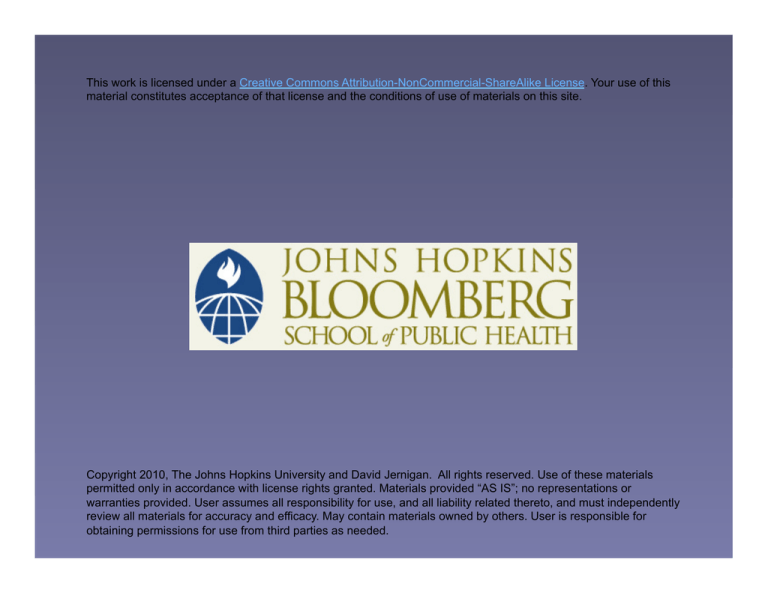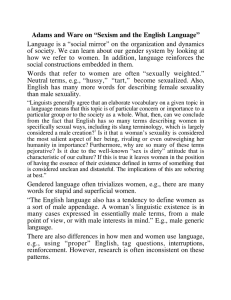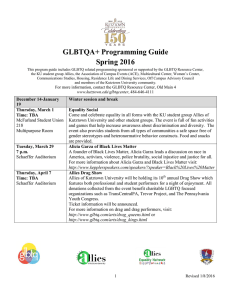
This work is licensed under a Creative Commons Attribution-NonCommercial-ShareAlike License. Your use of this
material constitutes acceptance of that license and the conditions of use of materials on this site.
Copyright 2010, The Johns Hopkins University and David Jernigan. All rights reserved. Use of these materials
permitted only in accordance with license rights granted. Materials provided “AS IS”; no representations or
warranties provided. User assumes all responsibility for use, and all liability related thereto, and must independently
review all materials for accuracy and efficacy. May contain materials owned by others. User is responsible for
obtaining permissions for use from third parties as needed.
Sex, sexuality and health
Class overview
Move from discussion of gender and sex
to discussion of sexuality and health
View through lens of social stigma,
understand kinds and effects of social
stigma
Use as an example to illustrate role of
social factors as determinants of health
problems
Case example: HIV
Public health and sex
Sexuality and behavior
Gender socialization plays significant role
Nexus of gender role inequality
Communication and conflict resolution
styles
Boys – more likely to use physical dominance
Girls – more likely to use verbal persuasion
Case example: HIV
Risk reduction (using a condom)
Action by male
Persuasion by female
Pleck et al. 1993 – even after controlling for SES and
personal background, boys with traditional attitudes
towards masculinity had
More sexual partners in past year
Less intimate relationship at time of intercourse
Greater belief M-F relationships are adversarial
More negative attitudes towards condom use
Less current use of condoms
Less belief in male responsibility to prevent pregnancy
Greater belief pregnancy validates masculinity
Case example: HIV
Most research ignores female experience of sex
Models inclusive of female experience of sex
incorporate understanding of:
Women’s history and current experience with
presence of threats and violence in relationships
(22% of women polled report assault by intimate
partner at least once)
Women’s fear – including fear occurring in response
to condom negotiation
Male attitudes regarding violence and abusive
behaviors towards women
Male history of threats or violence against women
Source: Amaro 1995
Bridging to sexuality
Public health and sex
The personal is political AND has health
implications
Sexuality is personal
Sexuality is complex
Some sexualities are stigmatized
Stigma
Erving Goffman 1963: Stigma: Notes on the
Management of Spoiled Identity
Life is role-playing – everyone manages their
identities
Two kinds of stigma
Discrediting – immediately visible – we “know the rules” of
the interaction
Discreditable – not immediately visible – issue less of
managing interaction than of managing information
Both forms important in thinking about health status of
populations
Three examples
Homeless
More likely to be discrediting than
discreditable
Disabled
Can be discrediting or discreditable
GLBTQ
Mostly discreditable
“T” issues particularly critical and challenging
GLBTQ
What is “gay”?
What kinds of actions provoke gay
oppression?
What are the social norms at stake in
existence and enforcement of gay
identities?
Source: ILGA, Creative Commons BY-ND
GLBTQ Health:
Areas of concern
(1) areas in which LGBT people are at an
increased risk for disease because of unique
exposures,
(2) areas in which they have high prevalences of
diseases or problems that are not caused by
unique exposures,
(3) areas in which they are not at increased risk for
disease but which nevertheless require
specialized culturally competent approaches.
GLBTQ and Health: Overview
Research challenge due to disclosure
issues
Samples often biased
Self-reporting may be less reliable
Health risks:
Violence (external and domestic)
Mental health issues (arrows of causation?)
HIV/AIDS
“MSMs”
GLBTQ and Health
“MSMs” – what is this category?
Is HIV the only health problem here?
Stall et al. 2003: Focus on HIV/AIDS masking
“syndemic” of other psychosocial health conditions
among MSMs:
Polydrug use
Depression
Partner violence
Childhood sexual abuse
Conditions mostly in significant relationships with each other
Accumulation of conditions increases HIV risk
GLBTQ and Health:
Costs of a managed identity
Mental and physical consequences of nondisclosure
Gay men with concealed identities at greater risk of:
Cancer
Infectious diseases
Faster progression of HIV infection
ATOD use
GB men twice as likely, LB women four times as likely
to have used marijuana in past year
GB men three times, LB women four times more likely
to have used ecstasy in past year
GLBQs more likely to smoke than general population
GLBTQ and Health
Increased risk for CVD
Lesbians
Higher rates of smoking
Higher body mass on average than heterosexual women
Less likely to report routine Pap smears
Increased risk of lung, cervical, other cancers
Access to health care as management issue
Transpersons
Need help for sex-based problems that are not readiliy apparent
due to visible gender identity
May be missed in routine screening due to visible gender identity
Deprivation of social supports in times of health care
crisis
Lack of legal protections for visitation, decision-making, funeral
preparations, etc.
SES: denial of fiscal rights, exacerbation of genderbased income differentials
Source for this and preceding slide: Lombardi and Bettcher in Levy and Sidel 2006
GLBTQ and Health
Societally-imposed definitions of identity
Medicalization
Culture-bound interpretations of both gender
and sexual behavior, and interactions of these
with other social categories such as race
Conflation of sexual orientation and gender
orientation
Assumptions about relationships between behavior
and identity
Discomfort with sexuality generally – “don’t ask,
don’t tell”
Populations with discreditable stigma:
common features
“Wish they would just go away”
Health status inextricably linked to social
definitions of, assumptions about population
Access to care influenced by stigma
Health gains come through social movements
ACT-UP
Disability Rights Movement
Homeless rights and organizing groups
Health gains come through changes in social
policies




